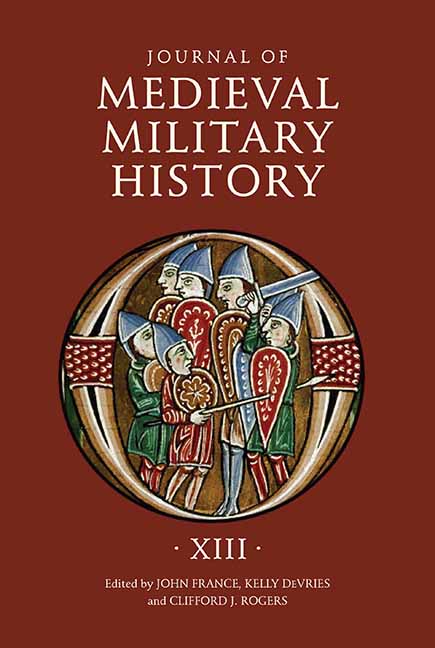Book contents
- Frontmatter
- Contents
- List of Illustrations and Table
- 1 Feudalism, Romanticism, and Source Criticism: Writing the Military History of Salian Germany
- 2 When the Lamb Attacked the Lion: A Danish Attack on England in 1138?
- 3 Development of Prefabricated Artillery during the Crusades
- 4 Some Notes on Ayyūbid and Mamluk Military Terms
- 5 Helgastaðir, 1220: A Battle of No Significance?
- 6 Por La Guarda De La Mar: Castile and the Struggle for the Sea in the Thirteenth and Fourteenth Centuries
- 7 The Battle of Hyddgen, 1401: Owain Glyndŵr’s Victory Reconsidered
- 8 The Provision of Artillery for the 1428 Expedition to France
- 9 1471: The Year of Three Battles and English Gunpowder Artillery
- 10 “Cardinal Sins” and “Cardinal Virtues” of “El Tercer Rey,” Pedro González de Mendoza: The Many Faces of a Warrior Churchman in Late Medieval Europe
- 11 Late Medieval Divergences: Comparative Perspectives on Early Gunpowder Warfare in Europe and China
- List of Contributors
- Journal of Medieval Military History 1477–545X
- De Re Militari and the Journal of Medieval Military History
9 - 1471: The Year of Three Battles and English Gunpowder Artillery
Published online by Cambridge University Press: 25 May 2021
- Frontmatter
- Contents
- List of Illustrations and Table
- 1 Feudalism, Romanticism, and Source Criticism: Writing the Military History of Salian Germany
- 2 When the Lamb Attacked the Lion: A Danish Attack on England in 1138?
- 3 Development of Prefabricated Artillery during the Crusades
- 4 Some Notes on Ayyūbid and Mamluk Military Terms
- 5 Helgastaðir, 1220: A Battle of No Significance?
- 6 Por La Guarda De La Mar: Castile and the Struggle for the Sea in the Thirteenth and Fourteenth Centuries
- 7 The Battle of Hyddgen, 1401: Owain Glyndŵr’s Victory Reconsidered
- 8 The Provision of Artillery for the 1428 Expedition to France
- 9 1471: The Year of Three Battles and English Gunpowder Artillery
- 10 “Cardinal Sins” and “Cardinal Virtues” of “El Tercer Rey,” Pedro González de Mendoza: The Many Faces of a Warrior Churchman in Late Medieval Europe
- 11 Late Medieval Divergences: Comparative Perspectives on Early Gunpowder Warfare in Europe and China
- List of Contributors
- Journal of Medieval Military History 1477–545X
- De Re Militari and the Journal of Medieval Military History
Summary
In the second half of the fifteenth century gunpowder began to change the face of warfare. While the impact of gunpowder has often been cited on the Continent, historians have failed until recently to give proper consideration to the role of gunpowder weapons in England's dynastic struggle known as the Wars of the Roses. John Gillingham, for example, has stated that “for all the growing importance of artillery, it remains true that this arm played only a minor role in the campaigns of the Wars of the Roses.” He maintained that the reason for the failure of the English to use gunpowder effectively was the lack of sieges in the extended conflict. Anthony Goodman believed that English strategy of the period was too focused on bringing the enemy to battle quickly and the armies were too hastily organized to allow the creation of a large siege train or the use of artillery. Kelly DeVries delivered a paper in 2001 which has since been published, showing the wide use of gunpowder artillery in local conflict by nobles, towns and even religious houses. Yet he argued that in only one instance did gunpowder weapons affect the outcome of the fighting in the Wars of the Roses. Conclusions such as those of Gillingham, Goodman and DeVries are beginning to be eroded because the evidence suggests that, in reality, English gunpowder weapons were as numerous and advanced as those on the Continent. David Grummitt examined the history of the Calais garrison, the largest professional military establishment in England during the Wars of the Roses. He ultimately determined that the Calais garrison served as the conduit for technologies and tactics into the English military establishment.5 Striking evidence has also been provided by the survey carried out on the battlefield at Bosworth. This survey found lead shot in such abundance that the survey team shifted the location of the battle several kilometers away from where many historians believed the majority of the fighting had taken place. Foard speculated in 2009 that perhaps the largest gathering of artillery in the British Isles occurred at Bosworth. However, in the final published volume on Bosworth, Foard was more circumspect, arguing that the fifteenth century, and in particular the Wars of the Roses, “may span a key transition in the battlefield use of gunpowder weapons – at least so far as artillery is concerned.”
- Type
- Chapter
- Information
- Journal of Medieval Military HistoryVolume XIII, pp. 193 - 212Publisher: Boydell & BrewerPrint publication year: 2015



